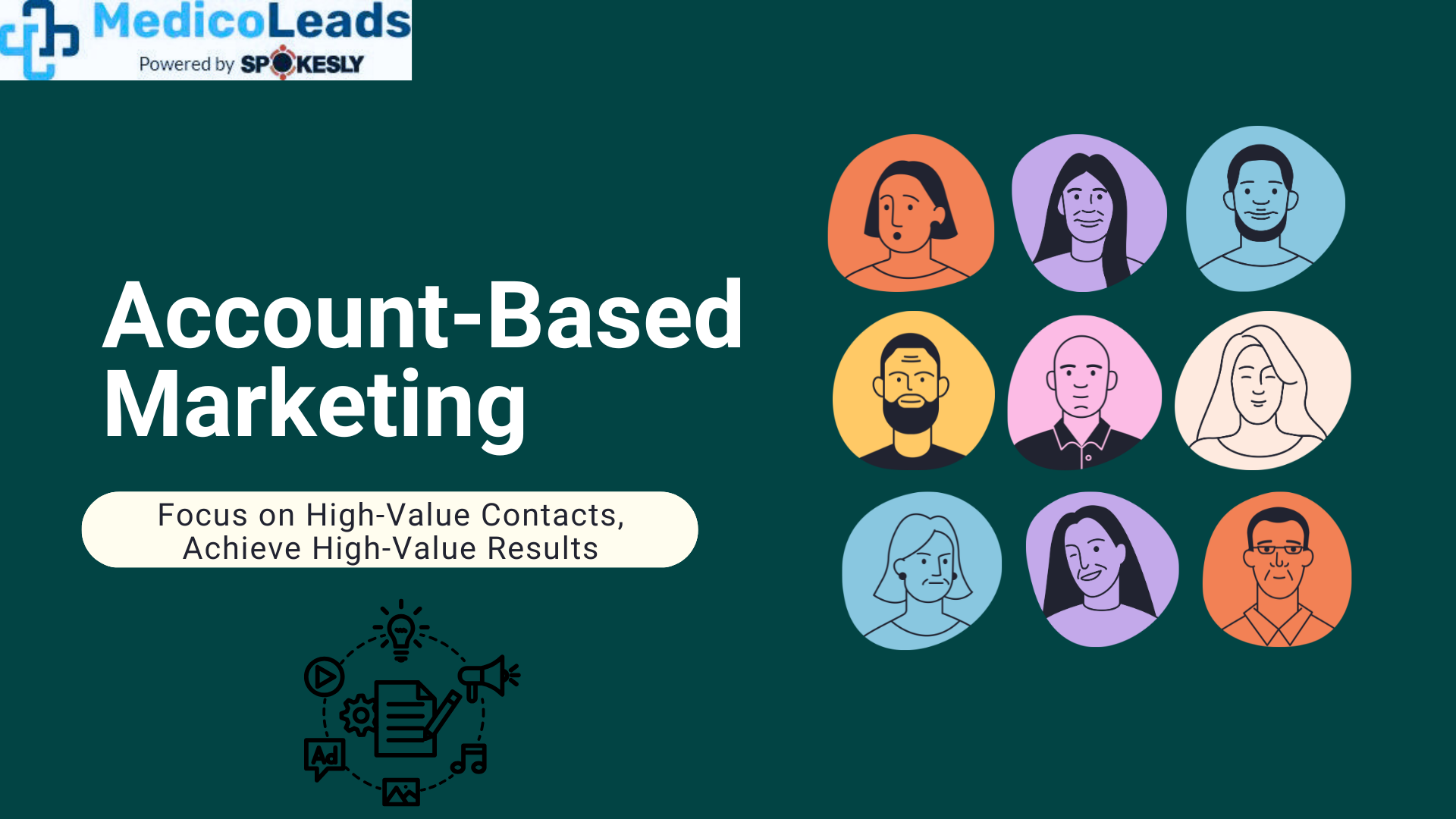ABM is a targeted B2B strategy that focuses on high-value healthcare accounts. It personalizes outreach to decision-makers in roles like procurement, clinical, and IT, improving engagement and conversion rates.

TABLE OF CONTENTS
Account-Based Marketing (ABM) helps healthcare marketers reach the right people—faster and smarter. In a space shaped by complex decisions and long sales cycles, generic outreach doesn’t work. ABM shifts the focus to high-value accounts with tailored messaging for each stakeholder.
ABM is not about more leads—it’s about better ones. With ABM, you can connect with procurement teams, department heads, and key clinical leaders through personalized, relevant content.
This blog breaks down how to apply ABM in healthcare, avoid common roadblocks, and align teams for real results. If you want to engage decision-makers and build lasting relationships, this is your starting point.
Read More!
1. What is Account-Based Marketing (ABM)?
Account-Based Marketing (ABM) is a B2B strategy that targets high-value accounts with personalized outreach. Unlike broad marketing tactics, ABM focuses on specific prospects with the highest potential return, aligning sales and marketing teams to tailor messaging.
In healthcare, ABM targets key decision-makers across roles—like procurement, clinical directors, and IT heads—ensuring content resonates with each stakeholder. This strategy shortens sales cycles, boosts engagement, and drives higher conversion rates.

2. Current Trends in Healthcare Account-Based Marketing (ABM)
Top 5 Must-Know ABM Trends to Boost Healthcare Marketing in 2025
To truly connect with decision-makers like hospital executives, procurement officers, or clinical leaders, more companies are turning to Account-Based Marketing (ABM).
So, what’s new in healthcare ABM in 2025? Let’s explore the top trends driving smarter, more personalized, and results-focused marketing strategies.
2.1. AI-Powered Personalization at Scale: Engaging Healthcare Decision-Makers with Precision
AI makes ABM smarter. It analyzes data to identify key buyer signals, behavior patterns, and intent. Marketers can then deliver timely, relevant messages to each stakeholder. This boosts engagement and speeds up decision-making. In healthcare, AI helps target complex buyer groups with precision—driving better results from every account interaction.
Pro Tip for ABM Teams: Leverage AI to automatically analyze user behavior, content preferences, and professional roles. Use these insights to trigger personalized, multi-channel campaigns that resonate with each account’s unique needs.
If you’re ready to bring AI-powered personalization to your ABM strategy, this is the moment to start.
2.2. First-Party Data Is King
MedicoLeads delivers accurate, compliant, and best healthcare email databases designed for healthcare B2B marketing. With verified data, businesses can streamline outreach, target the right professionals, and accelerate campaign success.
Pro Tip:
Use CRM and website analytics to continuously enrich your first-party data.
Ready to supercharge your ABM strategy with first-party data?
Let’s talk about how MedicoLeads can streamline your workflow and improve your outreach.
Start your ABM journey—reach out today!2.3. Omnichannel Engagement: Reaching Healthcare Professionals Beyond Just Email
Healthcare professionals engage on multiple channels—email alone isn’t enough. ABM works best when outreach spans channels like LinkedIn, webinars, phone, and personalized landing pages. This boosts visibility and drives deeper, more consistent engagement.
Pro Tip:
Map each stakeholder’s preferred channels. Use coordinated touchpoints across digital and offline platforms to reinforce messaging and improve response rates.
2.4. Tight Sales & Marketing Alignment: The Key to High-Impact ABM in Healthcare
Strong ABM starts with unified sales and marketing teams. Shared goals, data, and workflows ensure consistent messaging and targeted outreach. In healthcare, this alignment improves engagement, shortens sales cycles, and drives better account outcomes.
Pro Tip:
Hold regular alignment meetings. Use shared dashboards to track KPIs, update account insights, and fine-tune outreach strategies based on real-time feedback.
2.5. Interactive & Educational Content: A Cornerstone of Healthcare ABM Success
In ABM, content must inform and engage. Interactive tools, case studies, and explainer videos help healthcare buyers explore complex topics and make confident decisions. Educational content builds trust and drives meaningful engagement across the funnel.
Pro Tip:
Create content tailored to each stage of the buyer journey. Use formats like calculators, assessments, or demos to spark interaction and guide decision-makers toward the next step.
3. Top Challenges in ABM for Healthcare Providers
Let’s look at some of the key challenges marketers face when targeting to healthcare providers.
3.1. Complex, Multi-Stakeholder Buying Committees
Challenge: Healthcare buying decisions involve multiple departments—clinical, IT, finance, compliance, legal, procurement.
Impact: Hard to coordinate messaging and gain consensus across a diverse group.
Solution: Create persona-specific content and use CRM/ABM tools to map and track stakeholder engagement.
3.2. Long, Bureaucratic Sales Cycles
Challenge: The average sales cycle in healthcare can exceed 12–18 months.
Impact: Difficult to maintain engagement and accurately measure ROI in the short term.
Solution: Use multi-touch attribution and intent data to track account progress through the funnel; focus on nurturing and long-term relationships.
3.3. Strict Privacy and Compliance Regulations
Challenge: You must comply with HIPAA, GDPR, and other privacy laws. Sending PHI or targeting based on personal health data is prohibited.
Impact: Risk of legal penalties and reputational damage.
Solution: Work with legal/compliance teams to ensure content and outreach are HIPAA-safe, anonymized, and consent-based.
3.4. Targeting the Right Accounts with Accurate Data
Challenge: Healthcare data is often incomplete, outdated, or fragmented.
Impact: Waste of budget targeting non-ideal or ineligible organizations.
Solution: Use verified sources like Definitive Healthcare, ZoomInfo Healthcare, SK&A, IQVIA, or integrate with CMS datasets for provider profiling.
3.5. Limited Digital Maturity of Target Accounts
Challenge: Some provider organizations (especially small/rural hospitals or clinics) may have limited digital infrastructure or low responsiveness to digital channels.
Impact: Email, digital ads, and LinkedIn campaigns may underperform.
Solution: Use direct mail, in-person events, phone outreach, and referrals for digitally under-engaged accounts.
3.6. Sales and Marketing Misalignment
Challenge: ABM depends on close coordination, but healthcare sales and marketing teams are often siloed.
Impact: Leads get lost, inconsistent messaging, missed opportunities.
Solution: Implement shared KPIs, regular account planning, and joint engagement workflows between sales and marketing.
3.7. Difficulty Proving ROI
Challenge: With long cycles and multi-touch engagements, it’s hard to track influenced revenue or attribute closed deals.
Impact: Executives may doubt the program’s effectiveness.
Solution: Use ABM platforms (e.g., 6sense, Demandbase) with multi-attribution models and influence reporting.
Conclusion
Account-Based Marketing (ABM) enables healthcare marketers to engage high-value providers through personalized, multi-channel strategies. By leveraging AI-driven personalization and verified data, ABM can drive effective, compliant outreach.
MedicoLeads offers accurate, role-based email lists to connect with decision-makers and maximize ROI. Optimize your ABM strategy for long-term healthcare growth.
FAQs
How does ABM improve healthcare marketing?
ABM tailors content to individual stakeholders, addressing their specific needs, challenges, and decision-making roles. This approach increases relevance, shortens sales cycles, and boosts conversions in complex healthcare sales environments.
What are the key trends in healthcare ABM for 2025?
AI-powered personalization, first-party data, omnichannel engagement, sales & marketing alignment, and educational content are the top trends transforming healthcare ABM in 2025.
Why is AI important for ABM in healthcare?
AI enables data-driven, personalized outreach by analyzing buyer signals, intent, and behavior. It helps deliver timely, relevant content to healthcare decision-makers, improving engagement and shortening decision cycles.
What are the challenges of implementing ABM in healthcare?
Key challenges include multi-stakeholder buying committees, long sales cycles, strict privacy regulations, and the need for accurate data. Solutions involve persona-based content, CRM tools, and ensuring compliance.
How can ABM strategies help with long sales cycles?
ABM focuses on nurturing relationships and tracking multi-touch interactions over long periods, ensuring continuous engagement despite lengthy decision-making processes in healthcare.
What role does first-party data play in ABM?
First-party data is collected directly from users, offering accurate insights into buyer behavior and intent. It’s more reliable and privacy-compliant than third-party data, enabling personalized, targeted ABM outreach.
How can sales and marketing alignment boost ABM success?
Aligning sales and marketing teams ensures consistent messaging, synchronized goals, and targeted outreach. This collaboration speeds up the buying process and increases conversions.
What type of content works best for ABM in healthcare?
Interactive and educational content, like case studies, webinars, and calculators, helps engage decision-makers, build trust, and move them through the buyer’s journey in ABM campaigns.
How can I ensure my healthcare ABM strategy is compliant?
Adhere to HIPAA and GDPR regulations by using anonymized, consent-based outreach and working with legal teams to ensure all content and data handling meet privacy standards.
How can MedicoLeads support my ABM strategy?
MedicoLeads offers accurate, role-specific healthcare data, ensuring that you reach the right decision-makers. Their verified lists enhance your ABM campaigns, driving better ROI and compliance.
What are the best tools for ABM in healthcare?
Platforms like 6sense, Demandbase, and CRM integration tools help track engagement, measure ROI, and fine-tune ABM strategies. These tools support multi-touch attribution and real-time performance tracking.
Contact Us

